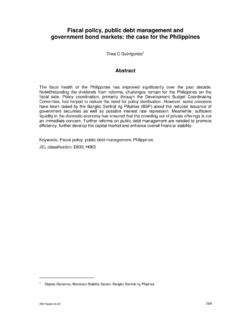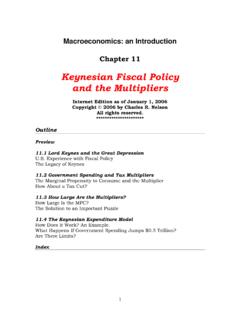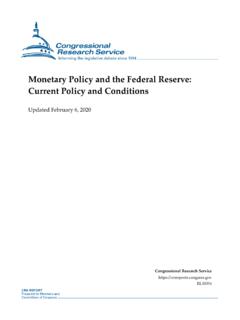Transcription of Fiscal Policy: Economic Effects - FAS
1 Fiscal policy : Economic Effects Updated January 21, 2021 Congressional Research Service R45723 Congressional Research Service SUMMARY Fiscal policy : Economic Effects Fiscal policy describes changes to government spending and revenue behavior in an effort to influence the economy. By adjusting its level of spending and tax revenue, the government can affect Economic outcomes by either increasing or decreasing Economic activity. For example, when the government runs a budget deficit, it is said to be engaging in Fiscal stimulus spurring Economic activity and when the government runs a budget surplus, it is said to be engaging in a Fiscal contraction slowing Economic activity.
2 The government can use Fiscal stimulus to spur Economic activity by increasing government spending, decreasing tax revenue, or a combination of the two. Increasing government spending tends to encourage Economic activity either directly through the purchase of additional goods and services from the private sector or indirectly by the transfer of funds to individuals who may then spend that money. Decreasing tax revenue tends to encourage Economic activity indirectly by increasing individuals disposable income, which can lead to those individuals consuming more goods and services. This sort of expansionary Fiscal policy can be beneficial when the economy is in recession, as it lessens the negative impacts of a recession, such as elevated unemployment and stagnant wages.
3 However, expansionary Fiscal policy can result in rising interest rates, growing trade deficits, and accelerating inflation, particularly if applied during healthy Economic expansions. These side Effects from expansionary Fiscal policy tend to partly offset its stimulative Effects . The government can use contractionary Fiscal policy to slow Economic activity by decreasing government spending, increasing tax revenue, or a combination of the two. Decreasing government spending tends to slow Economic activity as the government purchases fewer goods and services from the private sector. Increasing tax revenue tends to slow Economic activity by decreasing individuals disposable income, likely causing them to decrease spending on goods and services.
4 As the economy exits a recession and begins to grow at a healthy pace, policymakers may choose to reduce Fiscal stimulus to avoid some of the negative consequences of expansionary Fiscal policy such as rising interest rates, growing trade deficits, and accelerating inflation or to manage the level of public debt. Prior to the Great Recession of 2007-2009, the federal budget deficit was about 1% of gross domestic product (GDP) in 2007. During the recession, the budget deficit grew to nearly 10% of GDP in part due to additional Fiscal stimulus applied to the economy. The budget deficit began shrinking in 2010, falling to about 2% of GDP by 2015. In contrast to the typical pattern of Fiscal policy , the budget deficit began growing again in 2016, rising to nearly 5% of GDP in 2019 despite relatively strong Economic conditions.
5 This change in Fiscal policy is notable, as expanding Fiscal stimulus when the economy is not depressed can result in rising interest rates, a growing trade deficit, and accelerating inflation. The Coronavirus Disease 2019 (COVID-19) pandemic has caused a historically severe recession. Several relief bills were enacted in response, including the Coronavirus Preparedness and Response Supplemental Appropriations Act, 2020 ( 116-123); the Families First Coronavirus Response Act ( 116-127); the Coronavirus Aid, Relief, and Economic Security (CARES) Act ( 116-136); and the Paycheck Protection Program and Health Care Enhancement Act ( 116-139). These measures significantly increased the deficit, which totaled $ trillion in FY2020 and amounted to of GDP, the largest share since the end of World War II.
6 Additional coronavirus relief was included in the Consolidated Appropriations Act, 2021 ( 116-260). R45723 January 21, 2021 Lida R. Weinstock Analyst in Macroeconomic policy Fiscal policy : Economic Effects Congressional Research Service Contents What Is Fiscal policy ? .. 1 Expansionary Fiscal policy .. 1 Potential Offsetting Effects to Expansionary Fiscal policy .. 2 Investment and Interest Rates .. 2 Exchange Rates and the Trade Balance .. 3 Inflation .. 3 Fiscal Expansion Multipliers .. 4 Considerations Regarding Persistent Fiscal 5 Unsustainable Public Debt .. 6 Decreased Business Investment .. 6 Crowding Out Government Spending .. 7 Withdrawing Fiscal Stimulus .. 7 Potential Offsetting Effects to Withdrawing Fiscal Stimulus.
7 8 Investment and Interest Rates .. 8 Exchange Rates and the Trade Balance .. 8 Inflation .. 8 Fiscal Contraction Multipliers .. 8 Fiscal policy Stance .. 9 Figures Figure 1. Federal Budget Deficit/Surplus .. 10 Tables Table 1. Average First-Year Fiscal Multipliers for Stimulus in Selected Models .. 5 Contacts Author Information .. 11 Fiscal policy : Economic Effects Congressional Research Service 1 he federal government has two major tools for affecting the macroeconomy (in this case, the whole, or aggregate, economy): Fiscal policy and monetary policy . These policy interventions are generally used to either increase or decrease Economic activity to counter the business cycle s impact on unemployment, income, and inflation.
8 This report focuses on Fiscal policy . For more information related to monetary policy , refer to CRS Report RL30354, monetary policy and the Federal Reserve: Current policy and Conditions, by Marc Labonte. What Is Fiscal policy ? Fiscal policy describes changes to government spending and revenue behavior in an effort to influence Economic outcomes. The government can impact the level of Economic activity (often measured by gross domestic product [GDP]) in the short term by changing its level of spending and tax revenue. Expansionary Fiscal policy an increase in government spending, a decrease in tax revenue, or a combination of the two is expected to spur Economic activity, whereas contractionary Fiscal policy a decrease in government spending, an increase in tax revenue, or a combination of the two is expected to slow Economic activity.
9 When the government s budget is running a deficit (when spending exceeds revenues), Fiscal policy is said to be expansionary. When it is running a surplus (when revenues exceed spending), Fiscal policy is said to be contractionary. From a policymaker s perspective, expansionary Fiscal policy is generally used to boost GDP growth and the Economic indicators that tend to move with GDP, such as employment and individual incomes. However, expansionary Fiscal policy also tends to affect interest rates and investment, exchange rates and the trade balance, and the inflation rate in undesirable ways, limiting the long-term effectiveness of persistent Fiscal stimulus. Contractionary Fiscal policy can be used to slow Economic activity if policymakers are concerned that the economy may be overheating, which can cause a recession.
10 The magnitude of Fiscal policy s effect on GDP will also differ based on where the economy is within the business cycle whether it is in a recession or an Expansionary Fiscal policy During a recession, aggregate demand (overall spending) in the economy falls, which generally results in slower wage growth, decreased employment, lower business revenue, and lower business investment. As seen during the current recession caused by the Coronavirus Disease 2019 (COVID-19) pandemic, recessions often lead to serious negative consequences for both individuals and The government can replace some of the lost aggregate demand and limit the negative impacts of a recession on individuals and businesses with the use of Fiscal stimulus by increasing government spending, decreasing tax revenue, or a combination of the two.















